Yes, eye patches can boost your eyesight, especially for kids with conditions like amblyopia. By occluding the stronger eye, the patch encourages the weaker eye to work harder, fostering important neural changes. It’s an inexpensive and non-invasive solution with significant benefits when started early. Compliance can be tricky, but strategies can be employed to enhance adherence. There’s much more to explore about the effectiveness and nuances of patching, so keep going to uncover additional insights.
Key Takeaways
- Eye patches are effective for treating amblyopia by occluding the stronger eye, forcing the weaker eye to develop better vision.
- Regular use of eye patches, especially in children under seven, maximizes improvement in visual acuity and neural adjustments.
- Patching can lead to significant vision enhancement, but early intervention is crucial for optimal results.
- Compliance with patching regimens can be challenging, but strategies like counseling and rewards can improve adherence.
- Individual differences, such as age and initial vision severity, greatly influence the effectiveness of patching treatments.
The Historical Use of Eye Patches in Medicine

When you think about eye patches, you might picture pirates or superheroes, but their historical roots run deep in medicine. Ancient soldiers wore them to protect their eyes during battles, while knights donned visors in jousting tournaments. In the 16th century, French surgeon Ambroise Paré greatly advanced their medical use by applying eyepatches for treating eye injuries. Eyepatches were originally used to improve vision and protect eyes from various dangers, showcasing their significant role beyond mere aesthetics. Pirates popularized them for night vision or to hide wounds, but their functionality didn’t stop there. Today, eyepatches are vital for healing corneal abrasions, aiding recovery post-surgery, and even treating conditions like amblyopia and strabismus. Their evolution highlights not just a fashion statement but an important tool in preserving and enhancing vision throughout history.
How Eye Patching Improves Vision in Children
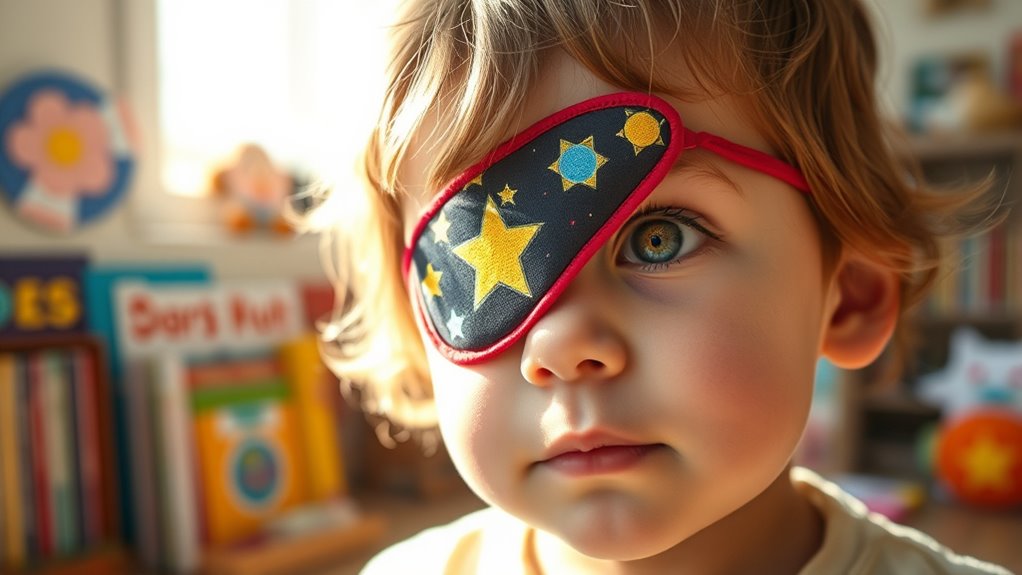
Eye patching plays an essential role in improving vision for children with amblyopia, a condition that affects their ability to see clearly. By covering the stronger eye, you force the brain to rely on the weaker eye, enhancing its vision.
Studies show that patching for just two hours daily can be as effective as six hours for moderate amblyopia. This noninvasive and inexpensive method is a preferred treatment option. Regular follow-ups with an eye specialist are vital to monitor progress and prevent issues with the dominant eye. Medical professionals should oversee the use of eye patches for best results. Remember, early treatment yields better results, especially for kids under seven, but even older children can still benefit from consistent patching.
Patching for just two hours daily can equal the effectiveness of six hours for moderate amblyopia, making it a preferred treatment.
Your support can make a significant difference in their vision improvement journey.
Different Types of Eye Patching Treatments
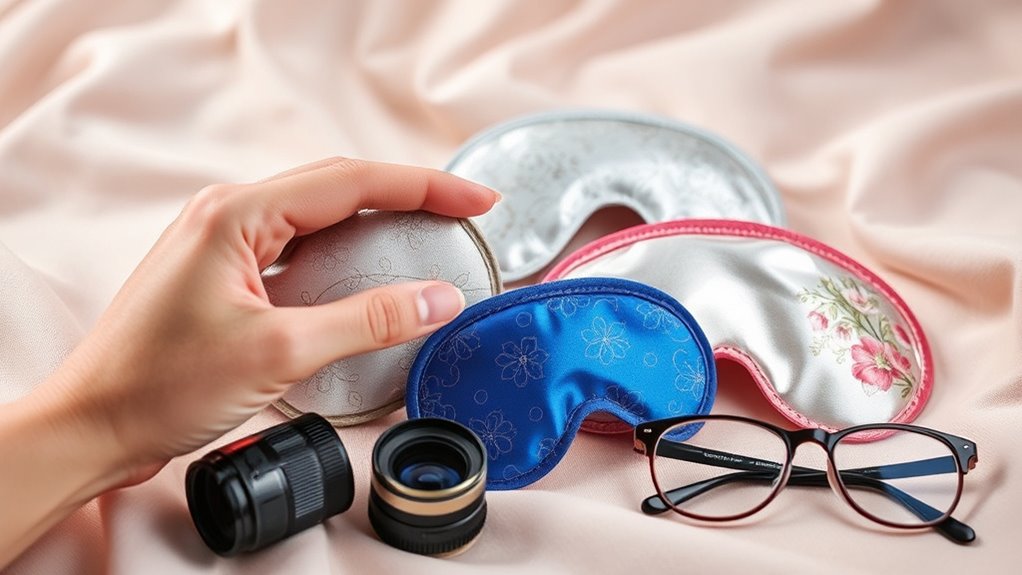
Various types of eye patching treatments cater to different vision issues and patient needs.
For amblyopia, adhesive patches are popular because they easily stick to the skin, especially for kids. If you’re dealing with strabismus, patches can help align your vision by occluding one eye.
Post-surgery, eye shields protect your eyes after procedures like cataract removal. To temporarily alleviate double vision, patches can block one eye’s vision. Additionally, eye patches are commonly used post-eye procedures for protection and healing.
You might also consider cloth or silk patches, which can be placed over glasses or provide comfort, respectively. Disposable patches are convenient but may not adhere well.
Selecting the right patch type guarantees better compliance, effectiveness, and comfort during your treatment journey.
The Science Behind Patching and Brain Development
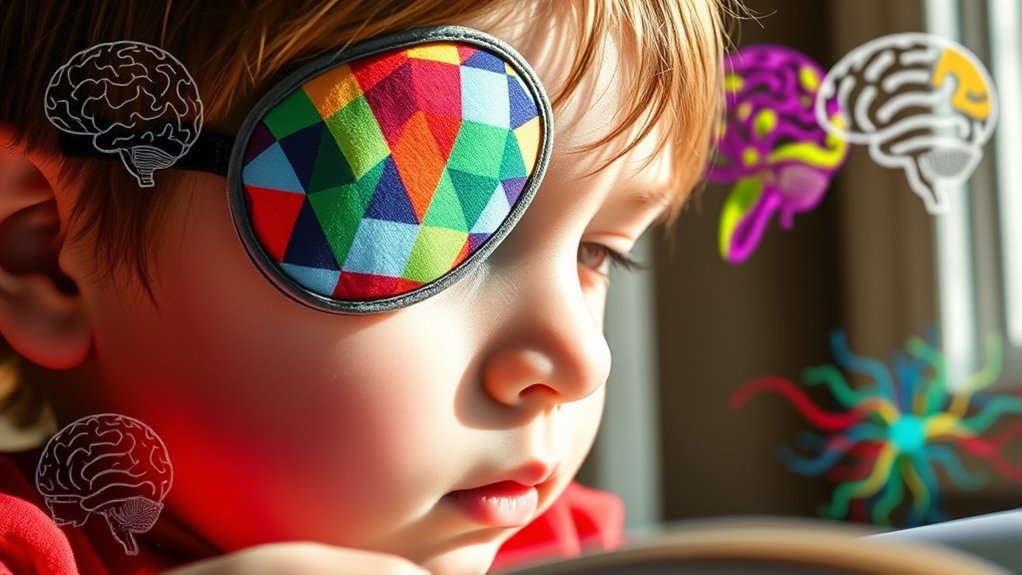
While the journey to better eyesight often involves physical treatments like patching, it’s equally important to understand the underlying science that drives brain development and visual improvement.
In the developing brain, your eyes compete for dominance, which can lead to amblyopia if one eye is weaker. Patching the stronger eye forces the weaker one to work harder, fostering neural adjustments.
During the critical period, usually before age 7, your brain shows remarkable plasticity, adapting to changes in visual input. Even older children and adults can experience benefits, as patching promotes adjustments in the brain’s vision center. This adaptability highlights the potential for improving vision, even beyond traditional treatment timelines. Ultimately, understanding these mechanisms can enhance your approach to vision therapy.
Clinical Trials: Evidence of Patching Efficacy

Clinical trials consistently demonstrate that patching is a highly effective treatment for amblyopia, especially in children aged 3 to 7.
However, older children and even teenagers can also benefit greatly from patching, showing that vision improvement is possible well into their teenage years. Studies reveal that the brain’s ability to adapt allows for this continued effectiveness beyond the previously believed age limit of 7. In a recent randomized clinical trial, Combined Atropine and Patching Therapy (CAPT) showed slightly greater mean improvement in amblyopic eye visual acuity compared to patching alone.
When compared to binocular treatments, patching stands out as a preferred option, though combination therapies may yield even better results in some cases.
Consistent adherence to patching regimens is essential, as higher compliance directly correlates with improved visual acuity.
Challenges in Adherence to Patching Regimens

Adhering to patching regimens can be challenging for both parents and children, as numerous factors complicate the process.
Children often resist wearing patches due to discomfort, social teasing, and the visual impact on activities. You might feel guilty about causing your child distress, which can strain your relationship.
Children may resist patching due to discomfort and social teasing, which can create guilt and strain parent-child relationships.
Additionally, skepticism about the treatment’s effectiveness can lead to inconsistent patching. While you may keep a diary of patching hours, it often overestimates actual compliance, making it difficult to assess progress. Nurse-led counselling can significantly improve adherence and motivation, making the patching process more manageable for families.
Consistency in applying patches during waking hours is essential for success, but younger children may struggle more with adherence.
These challenges highlight the need for understanding and support from healthcare providers to enhance compliance and motivation.
Strategies to Enhance Compliance in Patching
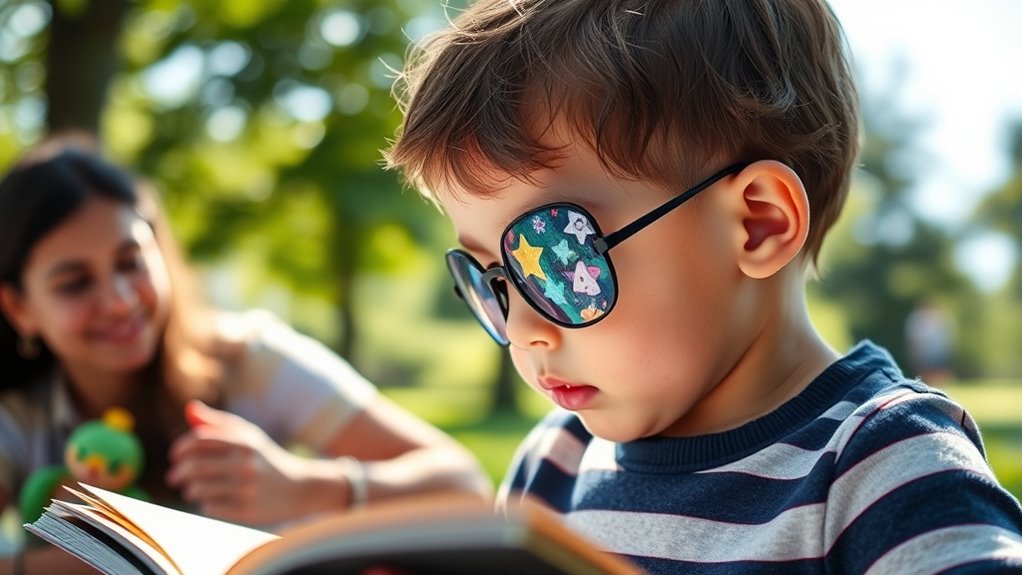
To enhance compliance in patching, it’s crucial to implement strategies that address both the child’s needs and the challenges parents face.
Start by explaining the benefits of patching in a way your child can understand. Make patching a routine part of daily life, and consider a reward system to motivate your child.
Let them choose or customize their patches, which can increase their willingness to wear them. Use timers to help them know when the patch will come off, and engage in fun activities together during patching. Engaging in fun activities can help make patch time more enjoyable and less of a chore.
Maintain open, positive communication and involve family members in the process. Finally, verify the patches are comfortable to wear by selecting hypoallergenic options.
Long-Term Effects of Eye Patching on Vision

While eye patching is a common treatment for conditions like amblyopia and strabismus, its long-term effects on vision can vary considerably among children. Typically, you’ll continue patching until your child’s vision improves, but some kids may not see significant gains. Early intervention, especially before age 7, usually results in better outcomes. This is largely because patching encourages the use of the weak eye, which is crucial for effective vision development. Regular check-ups are vital to monitor progress and adjust treatment as needed. If your child undergoes surgery, patching may be recommended both before and after to aid recovery. It’s important to taper off patching gradually to maintain vision gains and avoid relapse. Overall, while patching can be effective, each child’s response will differ, necessitating a tailored approach to treatment.
Understanding Variability in Treatment Outcomes
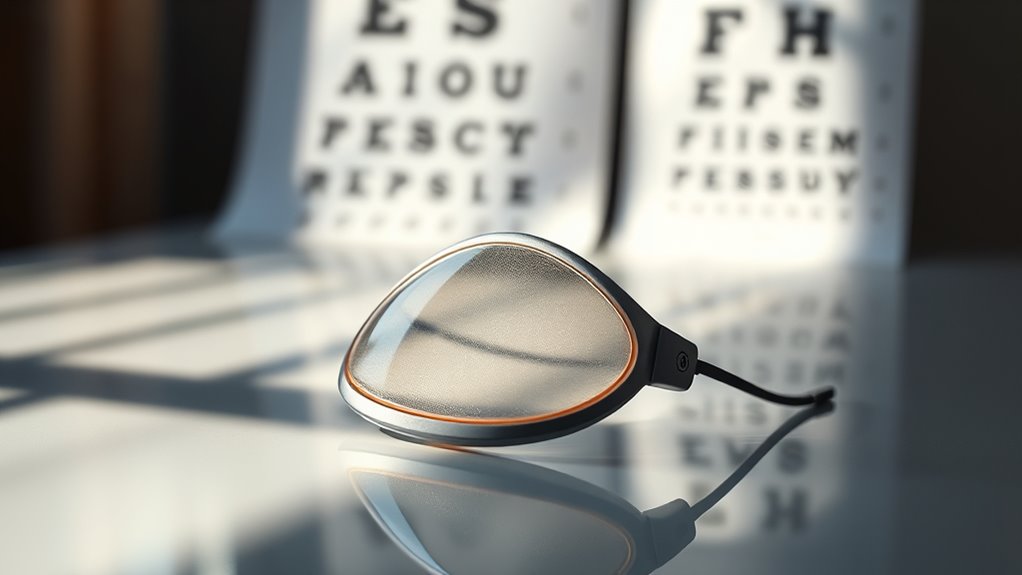
Understanding variability in treatment outcomes is essential, especially when you consider how individual differences can greatly affect progress. Your unique characteristics, like age and initial vision severity, play a significant role in how effective a patch might be for you.
Therapist factors also contribute, accounting for about 5% to 13.5% of outcomes. However, it’s often your engagement and expectations that matter most. Techniques used by therapists and their engagement style can impact results, sometimes even more than their formal training.
Additionally, if you’re taking medications, they could interact with the treatment’s effectiveness. By understanding these variabilities, you can better navigate your vision correction journey and advocate for more personalized interventions that truly work for you.
Frequently Asked Questions
Can Adults Benefit From Eye Patching for Amblyopia Treatment?
Yes, adults can benefit from eye patching for amblyopia treatment, though results vary.
While part-time patching is traditionally more effective in children, recent studies show that adults can still experience improvements.
You might see small gains in visual acuity, especially if you’re consistent with the treatment and engage actively during the process.
Combining patching with other therapies, like computer-based training, could enhance your overall outcomes and boost your vision even further.
Are There Any Side Effects of Wearing Eye Patches?
Imagine a child named Sam who’s wearing an eye patch to strengthen his weaker eye. While this can effectively improve vision, there are side effects you should consider.
Skin irritation from the adhesive is common, and Sam might also struggle with depth perception since his binocular vision is suppressed.
Additionally, he may face emotional challenges, like feeling self-conscious at school.
It’s important to monitor these effects closely to guarantee a positive experience.
How Long Does It Take to See Improvements From Patching?
When you use a patch for amblyopia, you can start seeing improvements in your vision within a few months of consistent use.
Typically, you’ll need to wear the patch for several hours each day over weeks or even years, depending on your specific situation.
For corneal abrasions, any benefits from patching mightn’t be noticeable, as healing times don’t differ greatly whether you’re patched or not.
Your comfort and adherence are key to success.
Can Eye Patches Be Used in Conjunction With Other Treatments?
Sure, you can totally go wild with eye patches!
Why not patch one eye while you’re rocking those stylish glasses or using atropine drops? It’s like a vision improvement party!
Patching your stronger eye pushes your brain to work harder with the weaker one, and combining treatments could maximize your results.
Just think of it as multitasking for your eyes—who wouldn’t want that?
What Materials Are Commonly Used in Eye Patches?
When you look at eye patches, you’ll find several common materials.
Cloth patches offer comfort, while adhesive ones stick directly to your skin.
Plastic is often used in eyeglass lens covers, blocking vision through one lens.
Gauze pads serve as disposable options after surgery, and elastic is found in non-adhesive patches for a snug fit.
Each material plays a unique role, catering to different needs and preferences in eye care.
Conclusion
In the end, using an eye patch can be like tuning a musical instrument; it takes time and patience to find the right harmony. Just as a violinist must practice diligently to create beautiful music, children must adhere to their patching regimens to improve their vision. While results may vary, those who stick with it often discover a clearer world awaits them. So, embrace the journey—your eyes might just hit the perfect note in the end.










